Navigation/Menü: Links auf weitere Seiten dieser Website und Banner
17.02.2006
HRSC Press Release #233 - Phobos Shadow (orbit 2345)
Die HRSC photographiert den Schatten des Marsmondes Phobos
Light and Shadow on the Surface of Mars
HRSC on Mars Express captures the shadow of Phobos on the ground
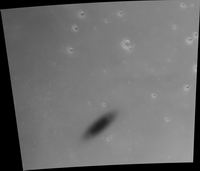 Grayscale Nadir Image |
On 10 November 2005, the camera experiment on Mars Express, the High Resolution Stereo Camera (HRSC), obtained images of the shadow of the Martian moon Phobos as it moved across the surface. These images, taken during orbit 2345, confirm the model of the moon's orbit around Mars, as it was determined earlier in 2004 also on the basis of HRSC images. They also show that with accurate image planning even moving objects can be captured exactly at their predicted position. The basis for such observations is the accurate knowledge of the spacecraft position on its orbit as well as of the targeted location on Mars within a few hundred meters.
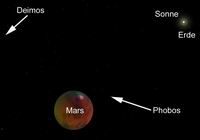 Context Map |
The larger of the two Martian moons, Phobos, has a size of about 27 kilometres × 21.6 kilometres × 18.8 kilometres and travels around Mars in an almost circular orbit. At an altitude of about 6,000 km, Phobos needs slightly more than 7.5 hours to complete a full revolution around the planet. When it is between the sun and Mars, Phobos casts a small and diffuse shadow onto the Martian surface. To a hypothetical astronaut observer on the ground, this would appear as a very quick eclipse of the sun. This is similar to an (though much slower) eclipse on the Earth, when the Moon covers the solar disk.
Der Schatten hat auf der Marsoberfläche die Form einer Ellipse, weil der von den Sonnenstrahlen verursachte Schattenkegel den Mars im Aufnahmegebiet schräg trifft. Die Verzerrung wird durch die besondere Aufnahmetechnik der HRSC noch verstärkt: Während der Schatten des Mondes mit cirka 7.200 Kilometer pro Stunde von West nach Ost über die Oberfläche wandert, bewegt sich Mars Express mit der deutlich höheren Geschwindigkeit von etwa 12.600 Kilometer pro Stunde von Süd nach Nord. Da die HRSC synchron zur Flugbewegung der Raumsonde die Oberfläche quer zur Flugrichtung abtastet - was eine gewisse Zeitspanne in Anspruch nimmt -, ist der normalerweise nur leicht ellipsenförmige Schatten in den HRSC-Bildern zu einer länglicheren Ellipse verformt.
The shadow of Phobos has an elliptical shape on the Martian surface, because the shadow's cone hits the surface under an oblique angle. This distortion is even enhanced by the particular imaging technique of HRSC. While the shadow moves across the surface with a speed of roughly 7,200 kilometres per hour from west to east, the spacecraft travels with a higher speed of approximately 12,600 km/h on its almost polar orbit from south to north. Since HRSC scans the surface synchronous to the flight velocity of Mars Express, it takes some time to cover the shadow in its full dimension. Within this short timeframe, however, the moon does move on, and therefore the shape of its shadow is ”smeared” in the HRSC image.
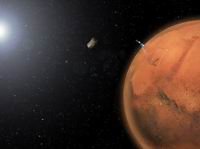 Image Footprint |
In addition to this phenomenon, the shadow is darker in its centre than near the edges. This can be explained by again taking the standpoint of the imaginary astronaut, who would look into the sun. Phobos with its small size is smaller than the solar disk and would cover it only to some 20%. Even if the astronaut were standing in the centre of the shadow, he or she would be illuminated from the uncovered part of the 219 million kilometres distant sun's disk, experiencing a partial instead of a total solar eclipse.
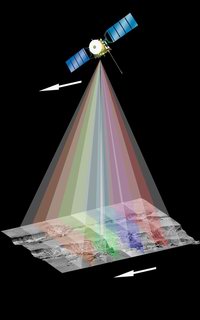 Data aquisition of HRSC |
HRSC has nine line sensors, which cover the surface one after the other due to the movement of the orbiter over the surface. While the first and forward-looking channel images the ground, the shadow of Phobos is still outside the imaged area (first sequence of the animation). Then the HRSC covers the field of view subsequently with the green channel, the panchromatic nadir channel, and the blue channel (second to fourth sequence of the animation). The complete imaging time for all channels is only a few minutes. By the time the last channel, another backward-looking panchromatic channel, observes the 41 km-wide field on the ground, the shadow has left the imaged area again.
Es ist nicht einfach, den kleinen und schnell wandernden Phobos-Schatten mit dem engen Gesichtsfeld des HRSC-Scannersystems »einzufangen«. Mitglieder des HRSC-Wissenschaftsteams konnten 2004 auf der Grundlage von Phobos-Nahaufnahmen der HRSC die Bahn des unregelmäßig geformten Marsmondes neu vermessen (siehe DLR Pressemitteilung vom 11. November 2004).
It is not trivial to observe the small and fast moving shadow with the narrow field of view of HRSC. Members of the HRSC Science Team re-calculated the orbit of Phobos on the basis of images taken in 2004 (see DLR press release or, respectively, ESA's image release of 11 November 2004).
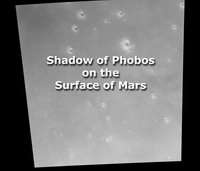 Quicktime-Movie |
With the help of the improved orbit determination - the moon has advanced approx. 12 km with respect to its previously predicted position along its orbit - it was possible to calculate those precise times when the shadow observations could be made. In turn, it was possible to verify the accuracy of the improved orbit determination by the shadow's position in the new images.
Dass der Schatten eingefangen werden konnte, ist der guten Zusammenarbeit des HRSC-Kamerateams am Institut für Planetenforschung im Deutschen Zentrum für Luft- und Raumfahrt mit den Mars Express Missionsingenieuren am European Space Operations Centre (ESOC), dem Bodenkontrollzentrum der Europäischen Weltraumorganisation ESA in Darmstadt zu verdanken. Dort muss die Planung für alle Aufnahmen bereits zwei Monate vor der tatsächlichen Bildaufnahme fertig gestellt sein, damit sie anschließend in den Bordcomputer der Sonde einprogrammiert werden kann. Anfang des Jahres 2006 ergaben sich weitere Beobachtungsmöglichkeiten des Phobosschattens, die vom HRSC-Experiment-Team in Kooperation mit dem ESOC bereits durchgeführt wurden, deren Ergebnisse aber noch nicht vollständig ausgewertet wurden.
These unique observations would not have been possible without the close cooperation between the camera team at the Institute of Planetary Research at DLR (Deutsches Zentrum für Luft- und Raumfahrt) and the ESA teams, in particular the mission engineers at the European Space Operations Centre (ESOC) in Darmstadt, Germany.
Das Kameraexperiment HRSC auf der Mission Mars Express der Europäischen Weltraumorganisation ESA wird vom Principal Investigator Prof. Dr. Gerhard Neukum (Freie Universität Berlin), der auch die technische Konzeption der hochauflösenden Stereokamera entworfen hatte, geleitet. Das Wissenschaftsteam besteht aus 40 Co-Investigatoren aus 33 Institutionen und zehn Nationen. Die Kamera wurde am Deutschen Zentrum für Luft- und Raumfahrt (DLR) unter der Leitung des Principal Investigators (PI) G. Neukum entwickelt und in Kooperation mit industriellen Partnern gebaut (EADS Astrium, Lewicki Microelectronic GmbH und Jena -Optronik GmbH). Sie wird vom DLR -Institut für Planetenforschung in Berlin-Adlershof betrieben. Die systematische Prozessierung der Daten erfolgt am DLR. Die Darstellungen wurden vom Institut für Geologische Wissenschaften der FU Berlin in Zusammenarbeit mit dem DLR-Institut für Planetenforschung erstellt.
The High Resolution Stereo Camera (HRSC) experiment on the ESA Mars Express Mission is led by the Principal Investigator (PI) Prof. Dr. Gerhard Neukum who also designed the camera technically. The science team of the experiment consists of 40 Co-Investigators from 33 institutions and 10 nations. The camera was developed at the German Aerospace Center (DLR) under the leadership of the PI G. Neukum and built in cooperation with industrial partners (EADS Astrium, Lewicki Microelectronic GmbH and Jena-Optronik GmbH). The experiment on Mars Express is operated by the DLR Institute of Planetary Research, through ESA/ESOC. The systematic processing of the HRSC image data is carried out at DLR. The scenes shown here were created by the PI-group at the Institute for Geological Sciences of the Freie Universitaet Berlin in cooperation with the German Aerospace Center (DLR), Institute of Planetary Research, Berlin.
Download
hochaufgelöste Bilddaten / full resolution image data
| Context Map: | TIF (3.1 MBs) / JPG (33.4 KBs) |
| Image Footprint: | TIF (1.4 MBs) / JPG (433.3 KBs) |
| Grayscale Nadir Image: | TIF (17.4 MBs) / JPG (1.7 MBs) |
| RGB Colour Image #1: | TIF (15.8 MBs) / JPG (287.5 KBs) |
| Data aquisition of HRSC: | TIF (18.3 MBs) / JPG (277.3 KBs) |

 Deutsch
Deutsch

